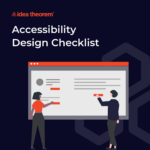Development & Engineering
How to Align Your Software Projects with Business Goals in 2025
07 MAY 2025
7 mins read


In today’s digital-first landscape, technology is more than just a support function—it’s a driver of growth, innovation, and competitiveness. Yet, many organizations struggle with aligning their software projects with their overall business objectives. Misaligned initiatives lead to wasted budgets, missed deadlines, and software that doesn’t deliver value.
At Ideatheorem, a trusted provider of software development services, we believe that successful digital products start with strategy. Whether you’re investing in custom software development, eCommerce services, or web development services, aligning your projects with business goals ensures measurable impact and sustainable growth.
Why Alignment Between Software and Business Goals Matters
When your software project aligns with your company’s mission, vision, and key performance indicators (KPIs), the outcomes are more predictable, impactful, and scalable. Benefits include:
- Higher return on investment (ROI)
- Improved stakeholder satisfaction
- Better resource utilization
- Reduced risk of project failure
- Stronger competitive advantage
Successful alignment allows businesses to move faster and smarter.
Step 1: Define Clear Business Objectives
Start by identifying your strategic business goals. Are you aiming to improve customer retention, increase revenue, automate internal processes, or expand into new markets?
Once defined, break these goals into measurable KPIs. For example:
- Increase customer engagement by 30% in 6 months
- Reduce support costs by 20% through automation
- Launch an eCommerce service targeting a new region
By setting concrete objectives, you ensure that your app development services or data science services are designed with purpose.
Step 2: Involve Stakeholders from the Start
Many projects fail due to miscommunication or lack of stakeholder input. Ensure your internal teams—marketing, sales, operations, and finance—are part of the early planning stages.
This collaborative approach fosters:
- Shared understanding of project value
- Better prioritization of features
- Clear expectations on deliverables
As a custom software development partner, Ideatheorem regularly hosts stakeholder workshops to ensure every perspective is heard before a single line of code is written.
Step 3: Choose the Right Software Development Partner
Your development team should be more than coders—they should be strategic partners. A capable software development service provider helps translate business needs into technical solutions with clarity and foresight.
When selecting a partner, consider:
- Domain expertise (e.g., healthcare, fintech, retail)
- Breadth of services: from web development services to QA testing services
- Agile and collaborative working models
- Proven success with aligning projects to KPIs
At Ideatheorem, we go beyond development. We immerse ourselves in your business to co-create meaningful and scalable solutions.
Step 4: Align Technology Stack with Business Strategy
Your choice of technologies should reflect your short-term needs and long-term scalability goals. Whether you’re developing a customer portal, internal ERP system, or launching a new eCommerce service, your stack matters.
Key questions to consider:
- Is the platform scalable as your customer base grows?
- Does it support integrations with existing tools?
- Can it accommodate future AI, data science services, or analytics features?
At Ideatheorem, we help clients evaluate and select technology stacks that align with their growth trajectories, performance demands, and budgets.
Step 5: Prioritize Features Based on Business Impact
Avoid building everything at once. Instead, focus on minimum viable products (MVPs) that deliver maximum business value with minimal complexity.
Example prioritization strategy:
| Feature | Business Value | Development Effort | Priority |
| Single Sign-On (SSO) | Medium | Low | High |
| AI Chatbot | High | High | Medium |
| Inventory Sync | High | Medium | High |
Using this matrix, you can roadmap features based on return-on-effort, ensuring each sprint aligns with the strategic vision.
Step 6: Integrate QA and Continuous Testing
Quality assurance is not a phase—it’s a mindset. Incorporating QA testing services from day one helps prevent costly bugs and ensures every release delivers on its promise.
Key QA practices to support alignment:
- Test-driven development (TDD)
- Automated regression testing
- User acceptance testing (UAT)
- Performance and scalability checks
Ideatheorem’s QA engineers collaborate closely with product owners to validate that every release supports business objectives—whether it’s boosting user satisfaction or reducing downtime.
Step 7: Use Analytics to Measure Alignment
Once your software is live, leverage analytics to measure performance against your original KPIs.
Track metrics like:
- User engagement and retention
- Conversion rates for eCommerce services
- Time saved through automation
- Uptime and support ticket volume
If you’re using data science services, consider implementing predictive models to forecast user behavior and market trends. These insights will help refine and realign your software over time.
Step 8: Iterate Based on Feedback
Software should evolve as your business grows. Post-launch feedback loops from users, employees, and stakeholders are crucial for continuous improvement.
Establish regular review cycles to:
- Analyze user behavior
- Gather stakeholder insights
- Plan for feature enhancements
This agile, feedback-driven approach ensures long-term alignment between your evolving business needs and your software products.
How Ideatheorem Aligns Technology with Business
At Ideatheorem, we take a consultative, strategic approach to every project. Here’s how we help align software with your business goals:
- Discovery Workshops: We learn about your goals, users, and pain points.
- Strategic Planning: We map software solutions to business KPIs.
- Cross-functional Teams: Designers, developers, analysts, and QA engineers work in sync.
- Full Lifecycle Support: From ideation to optimization, we ensure lasting value.
Whether you’re launching a digital product, automating workflows, or scaling your app development services, our expert team is committed to delivering business-aligned outcomes.
Conclusion
Aligning your software projects with your business goals isn’t just a best practice—it’s a competitive advantage. From planning and technology selection to testing and analytics, every decision should serve a clear strategic purpose.
By partnering with a results-driven firm like Ideatheorem, you ensure that every stage of developing a software product is aligned with your KPIs, market demands, and customer expectations.
📩 Looking to get started? Let Ideatheorem help you align your next software project for maximum business impact. Visit https://ideatheorem.com to learn more.





